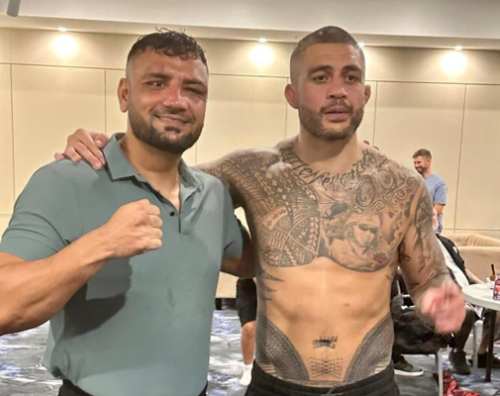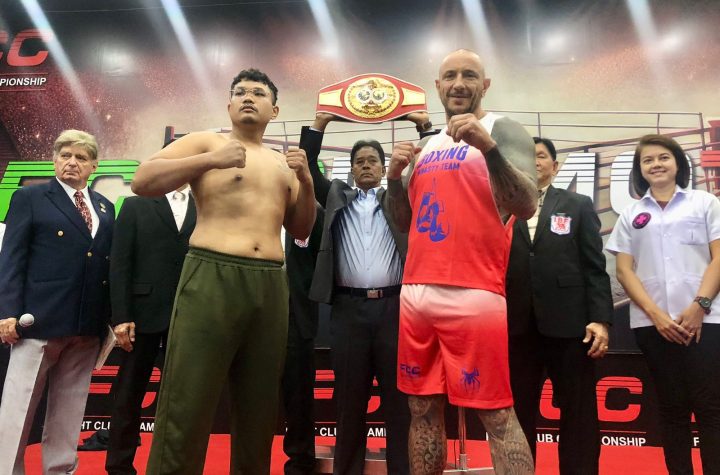
Bloodyelbow.com
“It’s almost here. Only four days left. Please MMA gods, don’t take this one away from us again.”
That was my opening paragraph drafting this piece on Sunday (for Tuesday publication), just before finding out the MMA gods hate us.
Yet they sometimes giveth after they taketh away, and UFC featherweight champ Max Holloway filling in on six days’ notice more than qualifies as a “giveth.” In fact, I’ll call it a positive-sum replacement as the matchup with Holloway feels more intriguing and exciting than the one we’ve fruitlessly looked forward to four times now and will no longer mention.
Win or lose, Holloway is an absolute stud for stepping up to give fans a show and attempt to become only the second UFC fighter to simultaneously hold a title in two different weight classes. Earning champion’s pay without the risk of losing your title? Ain’t half bad. The potential of shaving years off your career and health from a possible Khabeating? That’s a different story.
Add in strawweight champion “Thug” Rose Namajunas returning to prove her knockout of former dominant titleholder and standup queen Joanna Jedrzejczyk was no fluke, and I’m pumped up already… on a Tuesday.
Remember, what you’re about to read are not official UFC statistics. They’re alternative stats generated from the official statistics and designed to (1) give more weight to the recent present than the distant past and (2) not let one huge or horrible performance dominate the data.
See the notes at the bottom for definitions of certain statistics and check out an earlier piece for an explanation of how this works.
Khabib Nurmagomedov vs. Max Holloway
Holloway’s riding a 12-fight win streak since Conor McGregor took a decision from him 4 ½ years ago, while Khabib has never lost or even been terribly threatened in his UFC career.
The basic premise of this fight isn’t too difficult. If Holloway can keep things in open space at distance – where he spends 78% of his fight time – he should pick apart Khabib with respective volume of 31.7 head jab and 52.4 power attempts per five minutes in the position (P5M), 46% power accuracy, landing differentials of 5.8 head jabs and 7.0 power strikes P5M, and a knockdown in 13.8% of his rounds (increasing to 22% in his last three fights). If the fight goes to the ground or against the cage, welcome to Khabib’s world.
Khabib spends only 39% of his fights at distance where his offensive numbers aren’t amazing, but his head defense has been strong with only 18% of power shots getting through (27% average and a very hittable 36% for Holloway). When he attacks with power, Khabib’s been mostly a head-hunter, probably looking to get his opponent’s guard up for the inevitable takedown attempts where he’s a machine.
While Holloway defends 94% of takedown shots from distance, 93% of takedowns in the clinch, and hasn’t been successfully taken down since Clay Collard got him in August of 2014, recent cage compadres like Jose Aldo, Anthony Pettis, and Cole Miller don’t exactly strike takedown fear in the hearts of men.
Khabib not only strikes takedown fear in the hearts of men, but bears and every other kind of forest animal.
At distance, Khabib shoots for takedowns 128% more often than the typical lightweight and 6,686% more frequently than Holloway (not a typo). He lands at a solid 41% clip, 11% better than an average lightweight’s 30%.
If they clinch up, Khabib’s pressing opponents against the cage 87% of the time and landing a few power strikes while mostly looking for the takedown. He attempts an enormous 17.4 clinch takedowns P5M, 253% more than a typical lightweight’s 4.9. His 45% success rate isn’t exceptional but he’s basically that guy hitting on every girl at the bar. He only needs one to say yes and, according to Tyron Woodley, is “very, very persistent.”
Other than Gleison Tibau almost six years ago, there hasn’t been a UFC opponent Khabib couldn’t take down multiple times when trying (he didn’t attempt a takedown before finishingThiago Tavares early in the first round). As a result, he spends 47% of his fight time on the ground with top control.
That crazy stat needs repeating.
Almost half of Khabib’s alternative stats fight time (which also gives more weight to recent bouts) is spent making opponents’ lives a living hell from top position. And his version of hell from above is landing 71.6 power shots P5M – a full 58.1 more than the 13.5 workload of a “normal” guy and 37.0 more than the impressive 34.6 power shots Holloway lands P5M when he’s on top.
Two Holloway ground stats to watch out for: (1) While we haven’t seen much of him on bottom for a while, his standup rate is 36% worse than average and (2) opponents get to half guard or better on Holloway 60% of the time he’s on bottom.
Khabib on top is a scary enough. With half guard or side control, he’s damn near a monster.
While Holloway’s a crafty grappler, the loss of Ferguson means the submission threat facing Khabib has certainly diminished. Only one person has ever dared try to submit Khabib –Michael Johnson at UFC 205 – and he paid for it with 8 ½ minutes on bottom having the will to fight sucked from his soul, and an eventual kimura.
Holloway does seem to have one obvious weakness. The only upper-body takedown ever attempted on him was successfully executed by Justin Lawrence. So from a single data point, Holloway’s upper-body takedown defense is a pathetic and paltry 0%.
Boom! Data.
There’s your opening, Khabib.
Rose Namajunas vs. Joanna Jedrzejczyk
Last November, we got to see about 27 standing strikes from Namajunas before she snatched the strawweight title from the five-time defending champion Jedrzejczyk’s tapping hands. A grand total of five standing power shots landed to Jedrzejczyk’s head and one to her legs before things were polished off on the ground.
Running it back this Saturday, Jedrzejczyk’s chin has now been tested in three of her last four fights. Claudia Gadelha and Namajunas both knocked her down (with Thug Rose finishing the job) while Karolina Kowalkiewicz had her rocked and utilizing zombie defense at one point.
In contrast, Namajunas has now dropped each of her last two opponents – Michelle Watersonand Jedrzejczyk – neither of which are slouches on their feet. Her power stats have spiked, but she still puts on a varied attack with a little over half of each round contested at distance.
In that open space at distance, Jedrzejczyk throws out twice as much head jab volume as Namajunas and 5.9 more power strikes P5M. She’s a bit more accurate overall with her power than Namajunas, mainly because she throws 72% more strikes to the legs than average and almost never misses (landing 90%).
If cracking someone in the head is going to be a potential issue, as it has in three of Jedrzejczyk’s last four fights, Namajunas only lets 10% and 21% of opponents’ respective head jabs and power shots land while Jedrzejczyk’s been a more hittable at 18% and 27%. And Namajunas has never been knocked down while Jedrzejczyk’s statistical knockdown abilities are pretty weak. Her only time dropping an opponent was 3 ½ years ago in her first fight with Gadelha.
In the clinch, Namajunas is usually pressing her opponents against the cage (62% of the time) while Jedrzejczyk’s usually the one getting pressed and defending takedowns (66% of the time). Namajunas tends to get out-struck with power in the clinch by a wide margin, but she also goes for 177% more takedowns than average and lands an excellent 63%. The only problem is Jedrzejczyk possibly-suspect chin hasn’t affected her legit clinch takedown defense, where she stuffs 83% of attempts.
If a Namajunas takedown does come, Jedrzejczyk is a standup machine, getting back to her feet 386% more than a typical strawweight or 8.7 times P5M being controlled. But Namajunas thrives in scrambles and doesn’t necessarily need to keep Jedrzejczyk down to come out ahead. Five of Thug Rose’s six submission attempts either finished or threatened. Half led to a tap and two of the three she missed were classified by FightMetric as “tight,” meaning they were locked-in and threatening.
I’m still personally flip-flopping back and forth on who’s going to win this fight, but the model has a clear predicted winner so come back on Saturday at 6pm ET for precise win probabilities.
Michael Chiesa vs. Anthony Pettis
Pettis’ glaring weakness has always been his takedown defense. He only defends 56% of takedown shots from distance and 42% of clinch attempts (a number significantly lower than his official lifetime averages due to the recent work of RDA, Eddie Alvarez, Charles Oliveira, Max Holloway, and Dustin Poirier). Chiesa’s takedown volume and accuracy are better than average from distance and in the clinch and he’s 5-of-8 on his submission attempts – all chokes and all dominant in the sense that he’s unlikely to lose his position if they don’t work out.
Pettis’ rate of standing up from bottom is exactly average, but he reverses position 251% more than a typical lightweight. We all know his move. If he has his back taken by Chiesa, it’ll be interesting to see if he can pull it off yet again.
Felice Herrig vs. Karolina Kowalkiewicz
Evan Dunham vs. Olivier Aubin-Mercier
Ashlee Evans-Smith vs. Bec Rawlings
Be sure to return to Bloody Elbow this Saturday at 6pm ET for precise win probabilities and possible bets shortly before UFC 223 starts.
Notes: Strike attempts are for an entire five minute round in each position (P5M) and are categorized as jab or power. A jab is just a non-power strike. Strikes are documented based on where they land or are targeted (head, body, legs), not the type that is thrown (punch, elbow, kick, knee). Visible damage rate is per five minutes the fighter is not on his back. It’s hard to bust up someone’s face while lying on your back. Damage percentage is per power head strike and distance head jab landed. Knockdown rate is per five minutes at distance or in the clinch off the cage. Knockdown percentage is per power head strike landed while standing. It’s really hard to knock someone down if they’re already on the ground. Clinch control is having the opponent pressed against the cage. Ground control is having top position or the opponent’s back. Submission attempts are per five minutes of ground control minus time spent in the opponent’s guard plus time spent with the opponent in guard. A bout closeness measure towards zero means a fighter is in blowouts (win or lose) and towards 100 means he is in very close fights.





More News
Unconscionable Betrayal: Tyson Pedro Camp’s Shameful Swindling of Taimoor Khan
Casimero TKO’s Sanchez in 1st round
Raquinel wins WBC Continental Americas super flyweight title